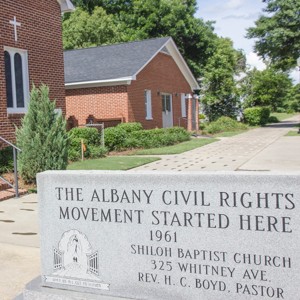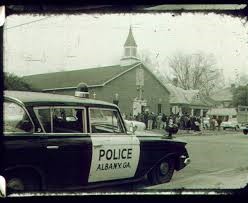Shiloh Baptist Church
Introduction
Text-to-speech Audio
Images
Albany Civil Rights Movement marker at Shiloh Baptist Church.

Crowds of people gathering at Shiloh Baptist Church to hear Dr. Martin Luther King Jr. speak.

Backstory and Context
Text-to-speech Audio
The history of Shiloh Baptist Church begins in 1888 when Reverend Sam Byrd came to Georgia. He and his followers took an old wooden frame house and molded it into a church, naming it the Shiloh Baptist Church. The old wooden building had tattered walls, barren floors, boarded windows, planked ceilings, and makeshift steeples. Reverend Bryd led the community until his death in 1914. Following the passing of Rev. Bryd, the community would go through several reverends until Rev. H. C. Boyd, known for his time in the Civil Rights Movement, joined the community in 1959.
Tragedy struck the community when, on February 19th, 1940, a tornado destroyed the original church building. Services for the community were held at Mt. Hebron Missionary Baptist Church and Simpson Hall until the church was rebuilt.
Under the guidance of Rev. H. C. Boyd, the church expanded massively over the next few years after his arrival. The church purchased additional property to create a larger parking area, erected an educational building, purchased vans that were to be used by its members, and completed several major renovation projects. The church also established a security team for the congregation’s safety, due to the rising amount of racial crime in this era.
During the 1960s the Shiloh Baptist Church played a major part in the Civil Rights Movement. The church was used by Black organizers to hold meetings and create plans for local civil rights marches. A coalition of Black improvement associations and student activists from SNCC and Albany State College organized at the church. The group set an unprecedented goal for the time, desegregating the entire community, from bus stations to lunch counters.
In 1961 Albany Georgia experienced its first civil rights march after the arrest of five Black teenagers. The teenagers had performed a sit-in at a local downtown bus station, sitting in a “For whites only” area, and defied police orders to leave, promptly being arrested. Following the sit-in, larger protests ensued and resulted in 600 more arrests, causing national attention and for Dr. King to visit Albany.
Dr. King’s visit caused a massive turnout, an estimated 1,500 people gathered at Shiloh Baptist Church, with an overflow crowd having to be hosted at the nearby Mt. Zion Baptist Church across the street. In December of 1961, Dr. King and hundreds of Black protestors were arrested in just one week. Dr. King would continue to organize and assist the movement from Shiloh Baptist Church but left in 1962 believing the movement had failed in Albany. Local organizers believed the contrary and simply thought the marches were a missed beat as African American voter registration was incredibly successful. Only two months after Dr. King had left Albany an African American businessman by the name of Thomas Chatmon secured a seat in the local commission and in the following spring the local commission removed all segregation from the books.
In 2014 a historical marker was erected in front of the church by the Georgia Historical Society and the Albany Civil Rights Institute to commemorate the historic organizing and gathering that took place here. The Reverend that had been the leader during the time of the Civil Rights movement, Rev. H. C. Boyd, passed away in 2016 at the age of 89. Today the church is still an active church that serves the local community.
Sources
http://www.albanyherald.com/news/2011/jan/15/mlk-history-remembered/?ts=1313599674&features http://www.albanygeorgia.biz/attractions/mustsee_civilrights.html
Community mourns the death of Civil Rights icon Rev. Boyd, Walb News 10. June 29th 2016. Accessed December 9th 2020. https://www.walb.com/story/32331399/community-mourns-the-death-of-civil-rights-icon-rev-boyd/.
Formwalt, Lee W.. Albany Movement, New Georgia Encyclopedia. December 2nd 2003. Accessed December 9th 2020. https://www.georgiaencyclopedia.org/articles/history-archaeology/albany-movement.
Hilton, Mark. Freedom Alley and City Hall, Historical Marker Database. May 5th 2018. Accessed December 9th 2020. https://www.hmdb.org/m.asp?m=117127&Result=1.
Hilton, Mark. Georgia Civil Rights Trail: The Albany Movement, Historical Marker Database. May 6th 2018. Accessed December 9th 2020. https://www.hmdb.org/m.asp?m=117148.
Lewis, Terry. Charles Burney to be installed as Shiloh Baptist Church’s new pastor, Albany Herald. February 10th 2017. Accessed December 9th 2020. https://www.albanyherald.com/news/local/charles-burney-to-be-installed-as-shiloh-baptist-church-s-new-pastor/article_30eed654-faf0-53ea-a080-26a0810292a5.html.
McEwen, Brad. Historical marker placed at Shiloh Baptist Church, Albany Herald. September 14th 2014. Accessed December 9th 2020. https://www.albanyherald.com/news/historical-marker-placed-at-shiloh-baptist-church/article_550cbd8f-3d41-57ba-982d-355dc193572d.html.
Must See Civil Rights, Albany Georgia. January 1st 2005. Accessed December 9th 2020. http://www.albanygeorgia.biz/attractions/mustsee_civilrights.html.
Shiloh's History, Shiloh Baptist Church. Accessed December 9th 2020. https://www.shilohbapt325albanyga.org/our-history.
Skiba, Pete. MLK, history remembered, Albany Herald. June 14th 2011. Accessed December 9th 2020. https://www.albanyherald.com/news/mlk-history-remembered/article_3aae6d12-3477-5d52-834a-8d1f66880674.html.
Turner, Irene. Albany Civil Rights Institute, New Georgia Encyclopedia. June 15th 2007. Accessed December 9th 2020. https://www.georgiaencyclopedia.org/articles/education/albany-civil-rights-institute.
